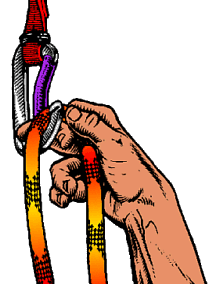
Although Polypropelene is not as strong as nylon it is in fact lighter. It is also stiff, very slippery and lacks the the ideal handling characteristics of nylon. Its strongest point rests in the fact that it hardly absorbs water and is therefor less likely to ice up while on a climb. Polypropelene has gained popularity as an ideal material for fixed mountain lines on mountaineering ascents, due to its light weight and water repellency.
Nylon is slightly less dense and has better abrasion resistance than does polyester. It also has better elongation and energy absorption properties than polyester. Neither is prone to mildew and both have comparable melting points and are dimensionally stable over a wide range of temperature. However, nylon loses more strength when wet and sunlight has a greater deterioration effect on nylon when compared to polyester. Finally, acids (eg..urine and battery acid ect...) attack nylon whereas bases (eg..caustic soda and lime ect...) attact polyesters. With respect to the above, nylon is the first choice for the manufacture of climbing ropes.
There are two types of nylon: Nylon 66 and Nylon 6 which can be refered to as Perlon. They both have high strength but nylon 66 stretches more under the same load. 66 has a higher melting point which is 260 degrees Celsius compared to perlon's 215 degrees. High melting points are desirable when climbing due to the heat generated by the rapelling and belaying devices. In comparison, polypropylene melts at a low 165 degrees.
NEVER, under any circumstances, use bleach when washing your rope. It is best to hand wash using mild or no detergent at all, rinse numerous times then HANG UP (no dryers or washers) in a cool and dry area. When not in use, store your rope in a dark, dry and cool spot. Watch for the possibility of chemical contamination. Wash your rope to remove the grit that can cut the inner fibers of the rope.
You should discard your rope when....
1. it has been damaged mechanically.
2. core feels abnormally thick or thin through the sheath.
3. mantle is badly worn through by abarsion.
4. has had a severe fall, though this is a judgement call as ropes are expensive.
5. five years and older or has been attacked by chemicals.
C.F.A. publications, 1982.
KARABINERS
There are two kinds of karabiners: safety karabiners, those with sleeves (locking gate), and those without, standard karabiners. The sleeve does not make the karabiner much stronger; it simply increases safety as it stops the gate from opening prematurely. Two standard karabiners can also be placed in opposition (gates facing opposite directions) to enhance security.
A basic karabiner has three axis; major, minor and perpendicular (right) axis. The major axis is the strongest and is designed to take the majority of the load in that direction only. The minor axis will take some of the load, depending on the design and brand of the carabiner. The right axis is the weakest and karabiners are not constructed to withstand loads in that direction.
There are five basic karabiner designs; Slant D, Wide Gate D, Pear, D Karabiner and Oval.
SLANT D -Available with or without a sleeve, the gate keeper is not parallel to the major axis and will therefor greatly reducing the chances of side-ways loading. The "D" shape is apparently stronger because it directs the load to the major axis, rather than allowing the load to spread throughout the karabiner.
WIDE GATE D -Usually, safety wide gate D's are the only ones available. The latter is ideal for belaying, belay stances and rescue work.
PEAR -They are weaker than wide gate because the design causes symmetrical loading, allowing the gate keeper to withstand half the load.
D KARABINER -With or without a sleeve, the D shape keeps most of the force off the gate keeper. Unfortunately, the gate keeper is in fact parallel to the major axis increasing the chances of side-ways loading.
OVAL -The weakest of the Karabiners, the gate keeper is in fact parallel to the major axis and symmetrical loading occurs. They are cheap, light and easy to deploy, though they will are not likely to sustain a severe fall on the minor axis. Oval Karabiners are usually not strong enough to qualify under the U.I.A.A levels.
Make a mental note: if something were to fall while you are climbing, be it a rock, equipment or even a camera, AVOID yelling "heads up". Using proper climber's terminology you would be inclined to yell "ROCK".